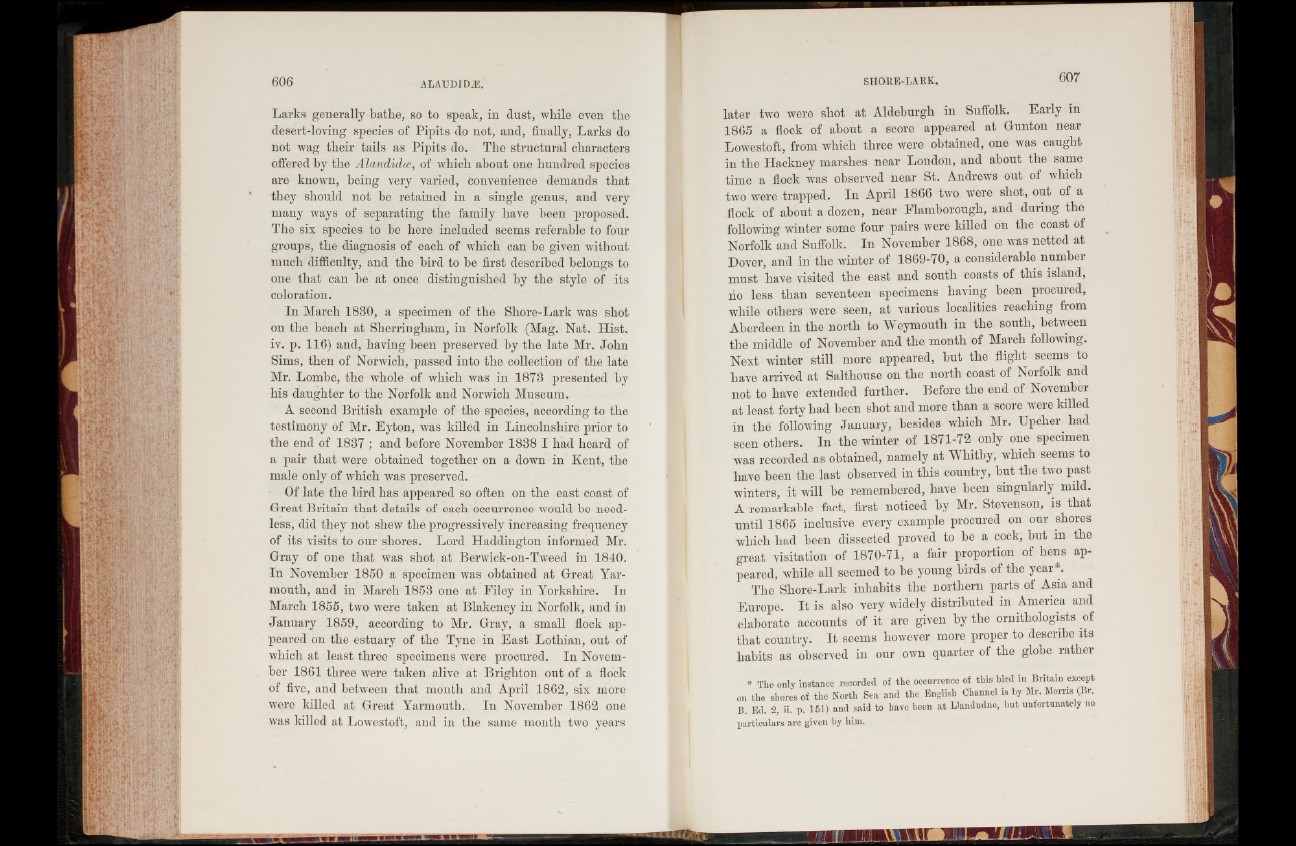
ill IS
Larks generally bathe, so to speak, in dust, while even the
desert-loving species of Pipits do not, and, finally, Larks do
not wag their tails as Pipits do. The structural characters
offered by the Alaudiclce, of which about one hundred species
are known, being very varied, convenience demands that
they should not be retained in a single genus, and very
many ways of separating the family have been proposed.
The six species to be here included seems referable to four
groups, the diagnosis of each of which can be given without
much difficulty, and the bird to be first described belongs to
one that can be at once distinguished by the style of its
coloration.
In March 1830, a specimen of the Shore-Lark was shot
on the beach at Sherringliam, in Norfolk (Mag. Nat. Hist,
iv. p. 116) and, having been preserved by the late Mr. John
Sims, then of Norwich, passed into the collection of the late
Mr. Lombe, the whole of which was in 1873 presented by
his daughter to the Norfolk and Norwich Museum.
A second British example of the species, according to the
testimony of Mr. Eyton, was killed in Lincolnshire prior to
the end of 1837 ; and before November 1838 I had heard of
a pair that were obtained together on a down in Kent, the
male only of which was preserved.
Of late the bird has appeared so often on the east coast of
Great Britain that details of each occurrence would be needless,
did they not shew the progressively increasing frequency
of its visits to our shores. Lord Haddington informed Mr.
Gray of one that was shot at Berwick-on-Tweed in 1840.
In November 1850 a specimen was obtained at Great Yarmouth,
and in March 1853 one at Filey in Yorkshire. In
March 1855, two were taken at Blakeney in Norfolk, and in
January 1859, according to Mr. Gray, a small flock appeared
on the estuary of the Tyne in East Lothian, out of
which at least three specimens were procured. In November
1861 three were taken alive at Brighton out of a flock
of five, and between that month and April 1862, six more
were killed at Great Yarmouth. In November 1862 one
was killed at Lowestoft, and in the same month two years
later two were shot at Aldeburgli in Suffolk. Early m
1865 a flock of about a score appeared at Gunton near
Lowestoft, from which three were obtained, one was caught
in the Hackney marshes near London, and about the same
time a flock was observed near St. Andrews out of which
two were trapped. In April 1866 two were shot, out of a
flock of about a dozen, near Flamborough, and during the
following winter some four pairs were killed on the coast of
Norfolk and Suffolk. In November 1868, one was netted at
Dover, and in the winter of 1869-70, a considerable numbei
must have visited the east and south coasts of this island,
no less than seventeen specimens having been proem ed,
while others were seen, at various localities reaching from
Aberdeen in the north to Weymouth in the south, between
the middle of November and the month of March following.
Next winter still more appeared, but the flight seems to
have arrived at Saltliouse on the north coast of Norfolk and
not to have extended further. Before the end of Novembei
at least forty had been shot and more than a score were killed
in the following January, besides which Mr. Upcher had
seen others. In the winter of 1871-72 only one specimen
was recorded as obtained, namely at Whitby, which seems to
have been the last observed in this country, but the two past
winters, it will be remembered, have been singularly mild.
A remarkable fact, first noticed by Mr. Stevenson, is that
until 1865 inclusive every example procured on our shores
which had been dissected proved to be a cock, but in the
great visitation of 1870-71, a fair proportion of hens appeared,
while all seemed to he young birds of the year*.
The Shore-Lark inhabits the northern parts of Asia and
Europe. I t is also very widely distributed in America and
elaborate accounts of it are given by the ornithologists of
that country. I t seems however more proper to describe its
habits as observed in our own quarter of the globe rather
* The only instance recorded of the occurrence of this bird m Britain except
on the shores of the North Sea and the English Channel is by Mr. Morris (Br.
B. Ed. 2, ii. p. 151) and said to have been at Llandudno, but unfortunately no
particulars are given by him.
I? :1
ill
a m T — ■ i •' f™